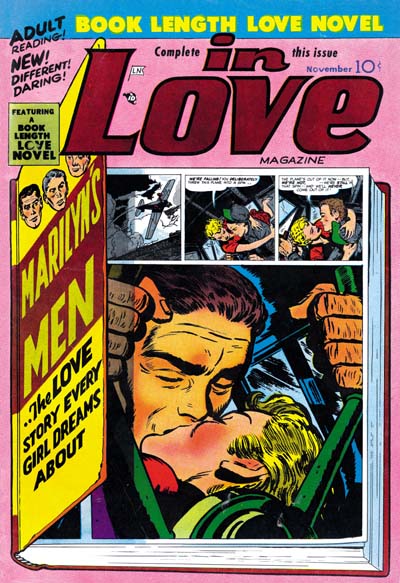
In Love #2 (November 1954) “Marilyn’s Men”, art by Bill Draut
The second issue of In Love kept to the concept of a long story broken up into three chapters. “Marilyn’s Men” is about Marilyn Morgan, her brother Jim, Lawyer Bob (he is actually called that), and Dave an airplane pilot. Jim is a constant source of scandals due to his numerous fights over girls, usually someone else’s. Lawyer Bob loves Marilyn, but unfortunately for him she does not return that affection. Marilyn heart still smolders for her high school flame Dave. Always on the look out for a big money making scheme, Jim entices Marilyn’s interest in a new project because this time it involves a deal with Dave for a new airport. This not only leads to a business partnership, but also to the renewal of love between Marilyn and Dave. All is not well because an attempt by Marilyn to prevent Jim from causing another scandal backfires with Jim leaving the partnership. But another scheme of Marilyn’s brings him back.
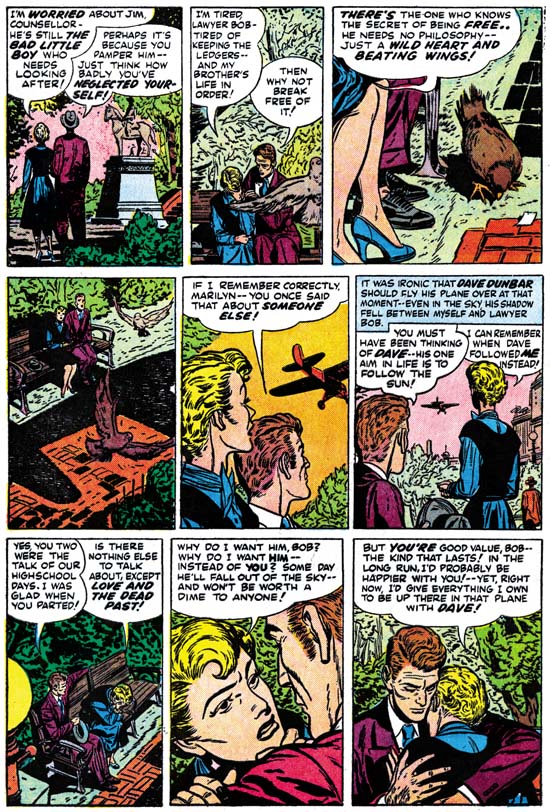
In Love #2 (November 1954) “Marilyn’s Men” page 6, art by Bill Draut
Most of the art in this story was done by Bill Draut, and he does a great job. There are a lot of examples I could provide. There is a nice fight scene that starts the story, a great splash page, some interesting flying sequences, and more. Instead I have selected a page with no real action because it shows how well Bill could choreograph a page. I suspect some of the credit should go to the writer for so nicely directing the whole thing. But it was probably Draut who figured how to visually make it all work. We see Marilyn and Lawyer Bob enter the park. As they sit there is a flying pigeon in the foreground. Next a close-up of a pigeon and the couple’s legs. Marilyn cites the pigeon as a metaphor for freedom. Then the pigeon is startled and flies away with the shadow of a plane showing the source of that disturbance. It is Dave’s plane that the couple look up at as if flies away. Finally it is back to focusing on the couple as we learn the depths of Marilyn’s feeling for and about Dave and Bob. All very cinematic.
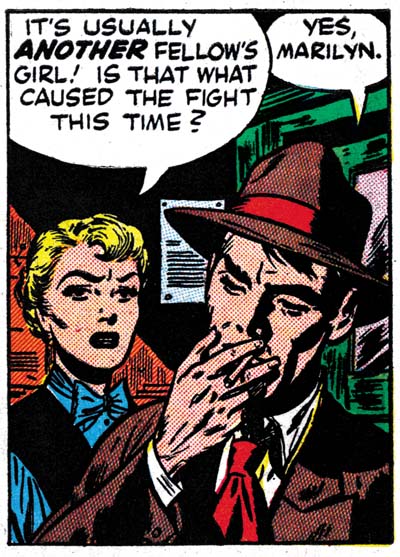
In Love #2 (November 1954) “Marilyn’s Men” page 4 panel 3, art by Bill Draut and Jack Kirby
That page and others do not have a Kirby feel to them so I once again doubt that Draut was working from Kirby layouts. There is one exception, a panel with Jim taking a drag from a cigarette while talking to Marilyn. Marilyn’s pose seems pure Draut, but Jim is so Kirby-like that I suspect Jack has stepped in to redraw the brother.
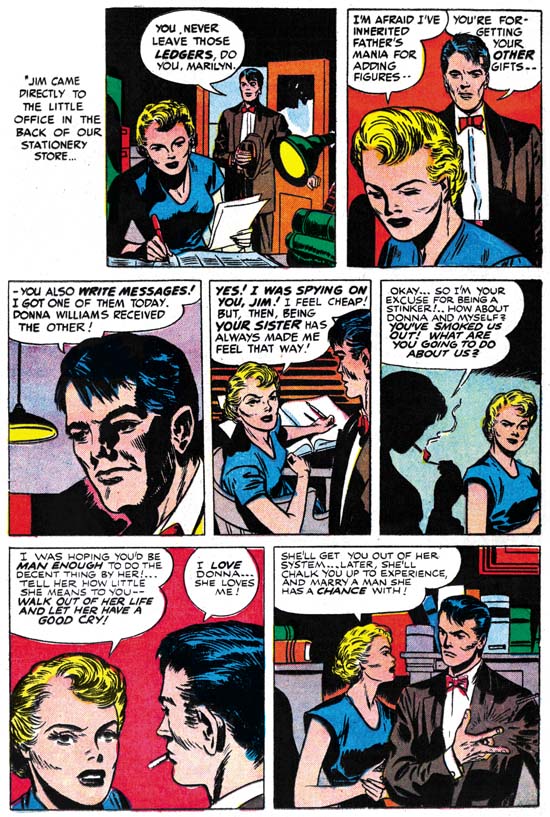
In Love #2 (November 1954) “Marilyn’s Men” page 18, art by Jack Kirby
Kirby did not draw any of the pages for the first two chapters of the story, but Jack did four of the seven pages of the last chapter. The first three pages are by Jack, followed by three pages by Bill and ending with another page by Kirby. I find it surprising that Jack’s contribution came so late in the story. Draut is a good artist but lets face it, Kirby is a better one, and also the boss. Normally I would expect that if Kirby only worked on part of a story it would be the splash pages and the start. An advertisement in In Love #1 shows that at least some of the art for “Marilyn’s Men” was already completed at the time issue #1 went to the printers. So perhaps Jacks significant involvement in In Love #1 precluded initially working on issue #2 until the last chapter. If chapter 3 is thought of as a story in itself, Jack’s involvement with the starting pages and the end is just what would be expected. Jack did a beautiful job on the splash page, I believe he inked it as well. I will discuss the second page of the chapter below but I do not believe Jack was the primary inker. The third page (shown above) is a bit of a surprise, although clearly drawn by Jack it looks like the inker tried to make it looked like it was done by Draut. I do not think it was Draut who did this inking. Previously I wrote on Kirby imitating Draut and other artists in the content pages of Harvey romances. What was done here was just as unsuccessful. I suspect the attempt was made to provide a transition from the Kirby page to those done solely by Draut. It does provide a transition but at the cost of a truly ugly page of art. The same sort of Kirby transformed into Draut occurs on the last page as well, and it is just as unsuccessful.
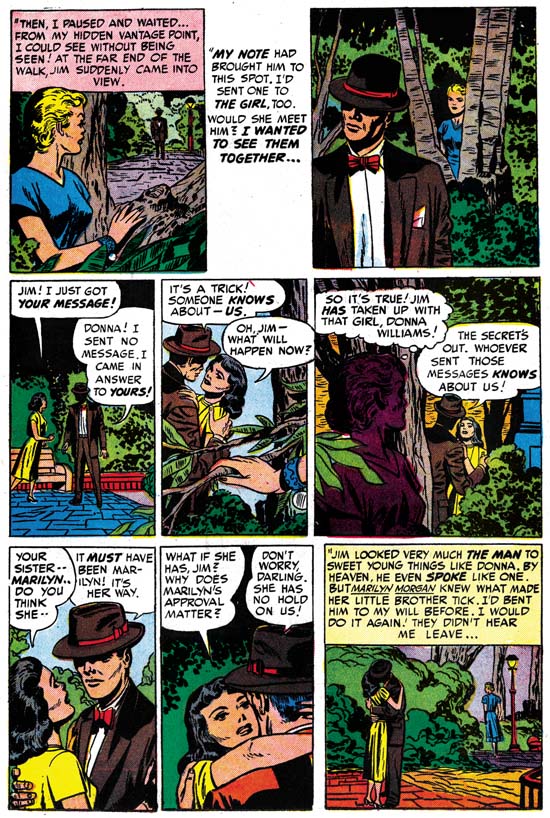
In Love #2 (November 1954) “Marilyn’s Men” page 17, art by Jack Kirby
I supply the image for the second page of the third chapter above (page 17 of the entire story). The sequence actually starts with two panels on the splash page showing Marilyn as she passes through the park alone. The first five panels on page 17 is a sequence of two of Marilyn and the man, followed by one of the man meeting another women and then another two of Marilyn and the couple. Except for one panel where the man is up close, Jack generally puts Marilyn in the foreground with the background used for the man or couple, who are the actual focus of the panels. The next two panels show only the couple and the last has the couple again with Marilyn retreating in the background. The whole sequence is just a marvelous example of obtaining drama and tension just by the way the art is laid out. Kirby is justly famous for how he portrays action in a story, action-less drama on the other hand is not something that Jack did not do very often. Although rare, pages like this one or the one I wrote about from Foxhole #2 show that Kirby was a master of pure drama as well.
The writing for this story is truly superior. All the pieces of the plot fit well together. Marilyn’s interference with her brother Jim in the last chapter makes no sense without Jim’s fight and scandal in the first chapter. The plot moves not just to provide an interesting tale, but as a means of presenting the cast of characters and providing their motivations. The character of Marilyn is a particular surprise. Generally a businesswomen in romance comics would be expected to abandon her career and find fulfillment in love. Not Marilyn, she gets it all, love and her career. When Marilyn’s interference in Jim’s love life backfires you would expect that she would have learn her lesson. Instead Marilyn no longer tries to break up Jim and his new girlfriend, but interferes once again in his life to bring him back to business partnership. One thing sets this story apart from many Simon and Kirby romances and that is emphasis on action. Since action is so often found in romance stories that Jack drew, I believe this indicates that Kirby played a significant part in the writing of this story. There are phrases here and there that also sound like Kirby’s writing. However most of the scripting does not sound like Jack’s, so I suppose another writer was involved as well.
As I reread these issues I realize that it is not just the full length feature story that sets In Love apart. Most romance comic book stories can be summarized as boy meets girl, a problem occurs, finally love conquers all. (Do not trivialize romance comics because of this, superhero stories can be summarized into an even simpler formula). The closest that In Love stories come to that formula is “Bride of the Star” that I posted on earlier. Even there it was so much as love conquered all as that the man regained his own self confidence about pitching which allowed love to resume. The two short backup pieces in In Love #1 were both about already married woman. “Marilyn’s Men” is just as much about Marilyn’s relationship with her brother as it is about her love life. The backup in In Love #2 was more about the love of a mother for her child then it was the love between a man and a woman. It does seem that Simon and Kirby were trying to make In Love different from the rest of the romance titles just like the effort to make the rest of the Mainline titles standout from their competitors.


Harry,
I agree with you completely. That Kirby page is simply amazing. He really knows how to use the “camera eye” and draw the reader into the story.